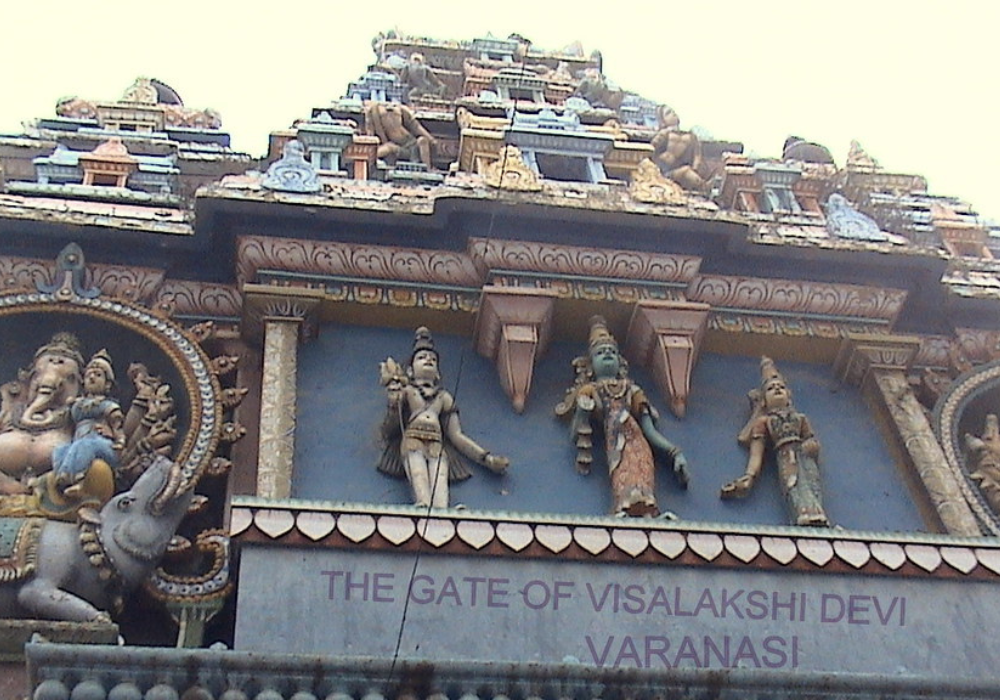
Varanasi, also lovingly known as Kashi, stands as one of India’s oldest and holiest cities. This spiritual heartland is home to countless revered shrines. Among these sacred sites, the Vishalakshi Temple holds a profoundly significant place. Often referred to as the Kasi Vishalakshi Temple or Vishalakshi Temple Varanasi, it is a powerful symbol of divine feminine energy. Indeed, this temple is considered one of the most important Shakti Peeths in India. Pilgrims from across the globe visit this sacred spot, seeking blessings and spiritual solace. Its rich history and deep mythological roots make it a truly captivating destination for devotees and cultural enthusiasts alike.
The temple’s name, Vishalakshi, translates to “one with wide eyes.” This beautiful epithet describes the all-seeing, compassionate gaze of the presiding deity, Goddess Parvati. Her wide eyes symbolize her ability to watch over and protect her devoted followers. This ancient shrine offers a unique glimpse into India’s profound spiritual heritage. Therefore, it remains a cornerstone of religious life in the venerable city of Varanasi.
Historical Roots and Mythological Significance
The origins of the Vishalakshi Temple are deeply intertwined with ancient Hindu mythology. Specifically, its history traces back to the legendary tale of Sati. Sati was the daughter of Prajapati Daksha, a powerful king. She chose to marry Lord Shiva, despite her father’s strong disapproval. Daksha later organized a grand yajna, a fire sacrifice, but intentionally excluded Sati and Shiva from the guest list. However, Sati decided to attend the yajna against Shiva’s wishes. At the event, Daksha publicly humiliated Lord Shiva. Unable to bear this profound disrespect towards her husband, Sati immolated herself in the sacrificial fire.
The Legend of the Shakti Peethas
Lord Shiva was overcome with immense grief and rage upon Sati’s death. He then carried her lifeless body across the universe. To restore cosmic balance, Lord Vishnu intervened. He used his divine Sudarshana Chakra to dismember Sati’s body into 51 or 52 parts. Each location where a part of her body fell became a sacred site known as a Shakti Peetha. These sites are infused with immense divine feminine energy. The Vishalakshi Temple Varanasi is one such revered Shakti Peetha. Tradition holds that either Sati’s eyes or her earrings (karna kundala) fell at this precise spot in Varanasi. This specific event gave rise to the temple’s name and its profound spiritual significance. Lord Shiva also established 52 Bhairavas to guard each Shakti Peetha. Consequently, the temple stands as a powerful testament to divine sorrow and subsequent cosmic rebalancing. It draws countless pilgrims seeking blessings from the Goddess.
Ancient Mentions and Enduring Legacy
The Kasi Vishalakshi Temple is mentioned in various ancient Hindu scriptures. Texts like the Devi Bhagavata Purana list Vishalakshi as one of the principal Shakti Peethas. Adi Shankaracharya, the revered 8th-century philosopher-monk, also visited this temple. He is credited with enshrining a Shri Yantra here. This act further solidified the temple’s spiritual importance. The consistent mention across different texts highlights its long-standing reverence. Moreover, its continuous worship for centuries underscores its enduring legacy. The temple has been rebuilt and renovated multiple times over history. This ongoing dedication reflects the unwavering faith of devotees. It also speaks to the profound spiritual energy that permeates this sacred ground. Thus, the temple remains a vital link to India’s ancient spiritual past.
The Sacred Shakti Peeth: A Divine Connection

The concept of Shakti Peethas is central to Shaktism, a major tradition of Hinduism. These holy sites are believed to be repositories of divine energy. They represent the cosmic power of Goddess Shakti. Each Peetha is linked to a specific part of Sati’s body. The Vishalakshi Temple in Varanasi is particularly special. It is one of the 18 Maha Shakti Peethas, considered highly significant. This makes it a prime pilgrimage destination for devotees. The powerful energy at this site is believed to grant wishes. Many seek wisdom, knowledge, and spiritual insight from the goddess. Furthermore, women often pray here for family well-being and wish fulfillment.
Vishalakshi: The Wide-Eyed Goddess
The name “Vishalakshi” literally means “one with wide eyes” in Sanskrit. This epithet is often used for Goddess Parvati. Her wide eyes symbolize her all-encompassing vision and compassion. She watches over all beings with an expansive, benevolent gaze. This divine aspect offers protection and guidance. The idol of Goddess Vishalakshi in the sanctum is a powerful representation. There are two murtis of Vishalakshi Devi in the sanctum sanctorum. One is the original ancient Murti, known as Adi Vishalakshi.
The other is a newer Murti, installed during a renovation by Tamil devotees. The newer idol, carved from polished black stone, often depicts her right arm holding a lotus. Her left hand points downwards, signifying blessings and generosity. Only the crowned head of the goddess is sometimes visible. The rest of her form is covered in yellow cloth. This profound imagery invites deep meditation and reverence. It reinforces the goddess’s role as a protector and bestower of blessings.
A Triad of Divine Eyes
Interestingly, the Vishalakshi Temple Kashi is part of a unique triad of temples in India. These three temples are symbolically connected to the eyes of the Goddess. The first is the Meenakshi Temple in Madurai, where “Meenakshi” means “fish-eyed.” The second is the Kamakshi Temple in Kanchipuram, where “Kamakshi” means “love-eyed.” Finally, the third is the Vishalakshi Temple in Varanasi, meaning “wide-eyed.” All three temples are immensely important religious destinations. They represent different facets of the divine feminine’s vision and power. Visiting these temples is considered highly auspicious. It allows devotees to experience the diverse manifestations of the Goddess. This triad emphasizes the profound spiritual connection across different regions of India. It also highlights the universal reverence for the divine feminine.
Architectural Splendor and Temple Layout

The Vishalakshi Temple Varanasi showcases a beautiful blend of architectural styles. Its design reflects the rich cultural influences prevalent in Varanasi. The temple features traditional North Indian Nagara-style elements. However, it also incorporates distinct South Indian architectural features. This unique fusion is particularly evident in its ornate gopuram. A gopuram is a monumental tower at the entrance. This impressive structure is adorned with intricate carvings and sculptures. Lions often guard the entrance, symbolizing strength and divine protection. Above the main entrance, a magnificent marble relief depicts Goddess Lakshmi. She is shown sitting on a lotus, with elephants showering her with water. This imagery symbolizes abundance and prosperity.
Inside the Sacred Complex
As visitors enter the temple complex, they are greeted by a spiritually charged atmosphere. The walls and pillars are adorned with intricate carvings. These artistic details enhance the aesthetic appeal of the temple. The main sanctum, known as the garbhagriha, houses the revered idols of Goddess Vishalakshi. As mentioned, there are two murtis: the ancient Adi Vishalakshi and a newer one. This “nesting” of shrines creates a unique, layered appearance. The inner periphery of the temple features a concrete wall.
This wall displays a variety of Shiva lingams, nagas (serpent deities), and a stunning Ganesh sculpture. A marble figure of Adi Shankaracharya, seated cross-legged, is also present. He is positioned directly behind the main shrine. This statue honors his significant contributions to the temple’s spiritual revival. The temple also has a room dedicated to the Navagrahas. These are the nine planetary deities from Vedic Astrology. They are often depicted in anthropomorphic form on an altar. Devotees offer flowers and vermilion powder to these celestial figures.
Symbolic Design Elements
The temple’s architecture incorporates profound symbolic elements. For instance, the small entrance of the temple is notable. It symbolizes the humility required before the divine. This compact gateway reminds visitors that no one is greater than God. The verandah in front of the main shrine is particularly ornate. Its concrete pillars are smoothly coated. They feature sculpted reliefs with floral motifs and yantras. These intricate details contribute to the temple’s spiritual ambiance. The overall design facilitates a meditative environment. It allows devotees to immerse themselves in prayer and devotion. The temple’s South Indian architectural style, especially its gopuram, hints at its patronage. The Nattukottai Nagarathar, a mercantile community from Tamil Nadu, built and maintains the temple. This cultural connection adds another layer of richness to its history. It also showcases the widespread influence of Hindu traditions.
Rituals, Festivals, and Daily Worship
The Vishalakshi Temple is a vibrant center of religious activity. A strict routine of daily worship is followed by the priests. This includes various rituals performed throughout the day. The atmosphere is consistently filled with devotional chants and the scent of incense. Devotees often bathe in the holy Ganges River nearby before offering worship. This purification ritual is a significant part of their spiritual practice. The temple welcomes visitors to participate in or observe these sacred ceremonies.
Daily Rituals and Offerings
The day at the temple begins with the auspicious morning aarti. During this ritual, priests chant hymns and offer lamps, flowers, and incense to the goddess. The Abhishekam ritual, a holy bathing ceremony of the Goddess, also takes place in the morning. Many devotees time their visit to coincide with these powerful ceremonies. Offerings are considered highly fruitful due to the presiding goddess’s power. Devotees often bring offerings such as coconuts, sweets, and red sarees. These are considered auspicious gifts for the goddess. Prayers are offered for success, wealth, and general well-being. Unmarried girls pray for a suitable groom. Childless couples seek blessings for progeny. Unfortunate individuals pray for a turn in their fortunes. The evening also features special prayers and aartis. These daily practices maintain a continuous flow of spiritual energy. They also provide a structured way for devotees to connect with the divine.
Major Festivals and Celebrations
The Kasi Vishalakshi Temple truly comes alive during major Hindu festivals. These celebrations are observed with immense devotion and enthusiasm. The two Navratris are the main festivals celebrated here. The Ashwin Navaratri, usually in October, culminates in Vijayadashami. It celebrates Goddess Durga’s victory over the buffalo demon Mahishasura. The Chaitra Navaratri occurs in March. During both Navratris, special aartis and rituals are performed. The temple is beautifully decorated with flowers and lights. Devotees visit Nav Durga temples during these periods. Thousands gather to witness the special pujas. They also take part in the festive atmosphere.
Another important festival is Kajali Teej. It is celebrated on the third day of the Bhadon month (Krishna Paksha), typically in August. This is a significant Hindu festival for married women. They pray for the long life of their husbands. Unmarried women pray for suitable grooms. Other notable festivals include Diwali, the festival of lights. Maha Shivaratri, dedicated to Lord Shiva, is also celebrated. The annual Vishalakshi Mahotsav is a unique festival. It is specifically dedicated to the presiding deity. This event draws pilgrims from all over India. The air fills with devotional songs and the fragrance of incense. These festivals offer a vibrant display of faith and tradition. They provide an immersive spiritual experience for all visitors.
Experiencing Devotion: A Visitor's Guide
Visiting the Vishalakshi Temple offers a profound spiritual experience. To make your pilgrimage smooth and enjoyable, some planning is helpful. The temple is situated at Mir Ghat, near Manikarnika Ghat. It is located on the banks of the sacred Ganga River in Varanasi. It is also not far from the famous Kashi Vishwanath Temple. Its central location makes it easily accessible for pilgrims and tourists alike. The calm atmosphere, combined with the chanting of mantras, creates a serene ambiance.
Temple Timings and Entry
The Vishalakshi Temple Kashi generally remains open throughout the day. However, specific timings for darshan (viewing the deity) and aarti ceremonies are important. The temple is typically open from early morning, around 4:30 AM or 5:00 AM, until late evening, around 9:40 PM or 10:00 PM. The most auspicious times for darshan are usually during the morning and evening aartis. During these times, the temple resonates with devotional hymns. The air is filled with the scent of incense. There is no entry fee to visit the Vishalakshi Temple Varanasi. This makes it accessible to everyone seeking the Divine Mother’s blessings. It is always wise to confirm current timings before your visit. Timings may change during special occasions or festivals.
Best Time to Visit
While you can visit the Vishalakshi Temple at any time, certain periods offer a more comfortable experience. The optimal period is generally from October to March. During these cooler months, temperatures are agreeable. This enhances the overall experience of exploring Varanasi. The summer months can be excessively warm. The monsoon season may bring considerable rainfall. Both can hinder outdoor activities and temple visits. Visiting during major festivals, such as Navaratri, offers a unique and vibrant experience. However, expect larger crowds during these times. Planning your visit during the cooler, festive months allows for a truly enriching spiritual journey. You can fully immerse yourself in the temple’s divine atmosphere.
Getting to the Temple
Varanasi is a well-connected city. Various modes of transportation are available to reach the Vishalakshi Temple.
By Air:
The nearest airport is Lal Bahadur Shastri International Airport (VNS). It is also known as Babatpur Airport. The airport is approximately 23-25 km from the temple. Regular flights connect Varanasi with major Indian cities. From the airport, you can easily hire a taxi or use local transportation. This journey typically takes around 40-45 minutes.
By Train:
Varanasi Junction (BSB) is the nearest major railway station. It is well-connected to various parts of the country. The temple is approximately 3-5 km from the railway station. Auto-rickshaws, e-rickshaws, and cycle rickshaws are readily available. They provide a convenient ride to the temple.
By Road:
Varanasi boasts a well-developed road network. You can reach the city by bus, car, or other private vehicles. Once in Varanasi, local transport options are plentiful. Auto-rickshaws, taxis, and local buses can take you to the temple. The temple is only about 3.9 km from Chaudhary Charan Singh Bus Stand. Its proximity to other landmarks makes it an ideal starting point for exploring Varanasi’s religious sites.
Exploring the Spiritual Heart of Varanasi (Kashi)
The Vishalakshi Temple is a significant part of Varanasi’s spiritual landscape. However, the city offers a wealth of other sacred sites and experiences. A visit to this ancient city is a journey into India’s profound spiritual heritage. Many pilgrims combine their visit to the Kasi Vishalakshi Temple with other nearby holy places. This allows for a comprehensive spiritual exploration. The city itself is considered one of the seven holy “puris” of Hindus. It is believed that Varanasi will endure even after the Pralaya, or cosmic dissolution. This emphasizes its eternal significance.
Nearby Attractions and Temples
Several important landmarks are located very close to the Vishalakshi Temple Varanasi. These include:
Kashi Vishwanath Temple: This is one of the most famous temples in India. It is dedicated to Lord Shiva. It is also one of the twelve Jyotirlingas and approximately 1.0 km away from the Vishalakshi Temple. Many pilgrims walk between these two significant temples.
Dashashwamedh Ghat: Situated around 600 meters from the Vishalakshi Temple, this is one of the oldest and most prominent ghats along the Ganges River. It is renowned for the spectacular Ganga Aarti performed every evening. This devotional ceremony involves music, fire, and chanting. It creates a mesmerizing atmosphere.
Manikarnika Ghat: This is one of the oldest and most sacred cremation grounds in Varanasi. Its proximity to the Vishalakshi Temple adds to the spiritual significance of the area. It is believed that those cremated here attain moksha, or liberation from the cycle of rebirth.
Annapurna Devi Temple: Dedicated to Goddess Annapurna, the goddess of food and nourishment, this temple is only about 220 meters away from the Vishalakshi Temple. Devotees often visit this temple after paying homage to Vishalakshi Devi.
Pashupatinath Temple, Varanasi: This temple is dedicated to Lord Shiva in the form of Pashupatinath. It is approximately 150 meters from the Vishalakshi Temple. It is considered the only Pashupatinath temple in Uttar Pradesh.
Ratneshwar Mahadev Temple: Also known as Kashi Karvat Temple, this site is about 1.5 km from Vishalakshi Temple. It attracts many visitors seeking blessings.
Sankat Mochan Hanuman Temple: A very popular temple dedicated to Lord Hanuman, located about 2.45 km from Vishalakshi Temple.
Kala Bhairava Temple: This temple is dedicated to Lord Kala Bhairava, the guardian deity of Varanasi. It is around 0.95 km from Vishalakshi Temple.
Tulsi Manas Mandir: A temple dedicated to Lord Rama, featuring verses from the Ramcharitmanas.
Ramnagar Fort: A historical fort located about 4.68 km from the temple.
These nearby attractions offer a diverse range of spiritual and cultural experiences. They allow visitors to delve deeper into Varanasi’s rich heritage. Exploring these sites alongside the Vishalakshi Temple provides a holistic pilgrimage. It truly enhances one’s understanding of this sacred city.
Planning Your Pilgrimage to Vishalakshi Temple
A pilgrimage to the Vishalakshi Temple is a deeply enriching experience. To ensure a smooth and memorable trip, consider these practical tips. Varanasi is a bustling city, so planning ahead can enhance your visit. The temple itself is a place of peace and devotion. Therefore, approaching it with reverence is important. You can easily spend 30 minutes to an hour inside the temple. However, many devotees choose to spend longer. They immerse themselves in prayers and meditation.
Accommodation and Local Transport
Varanasi offers a wide range of accommodation options. These include luxurious hotels to budget-friendly guesthouses. Many hotels are located near the ghats and major temples. This provides convenient access to the Vishalakshi Temple. Some popular options include BrijRama Palace, Hotel Sahu, and Hotel Ganges Grand. Booking your stay in advance, especially during peak season, is advisable. This ensures availability and better rates. Once in Varanasi, local transport is readily available. Auto-rickshaws, e-rickshaws, and cycle rickshaws are common. They offer easy navigation within the city. Walking is also a great way to explore the narrow lanes and ghats. It allows you to soak in the city’s unique atmosphere.
Respecting Local Customs
When visiting the Kasi Vishalakshi Temple and other sacred sites, observing local customs is essential. Dress modestly, covering your shoulders and knees. Remove your footwear before entering the temple premises. Photography policies can vary inside temples. It is best to check with temple authorities upon arrival. Generally, photography is restricted in the main sanctum. However, it may be allowed in other areas. Maintain a respectful demeanor inside the temple. Avoid loud conversations. Participate in rituals if you feel comfortable. The serene environment is conducive to quiet contemplation. Engaging with locals respectfully can also enrich your experience. They can offer insights into the temple’s significance. They may also share local traditions.
Health and Safety Considerations
Varanasi can be quite crowded, especially around popular temple areas and ghats. Be mindful of your belongings. Stay hydrated, especially if visiting during warmer months. It is advisable to carry a water bottle. Wear comfortable footwear, as you will likely do a lot of walking. Consider consulting a local tour service for guidance. They can help with navigation. They can also provide deeper religious insights. This ensures a more informed and safe pilgrimage. Furthermore, be aware of the local time. Varanasi observes Indian Standard Time (IST). This can help you plan your day effectively. Enjoy your journey to the heart of spiritual India.
Frequently Asked Questions About Vishalakshi Temple
Q1: What is the main significance of Vishalakshi Temple?
The Vishalakshi Temple is primarily significant as one of the 51 or 52 Shakti Peethas. These are highly revered shrines dedicated to Goddess Shakti, the divine feminine. It is believed that Sati’s eyes or earrings fell here. This makes it a powerful site for devotees seeking blessings and spiritual fulfillment.
Q2: Where is the Vishalakshi Temple located in Varanasi?
The Vishalakshi Temple is located at Mir Ghat in Varanasi, Uttar Pradesh, India. It is situated near the sacred Manikarnika Ghat and on the banks of the River Ganges. It is also very close to the famous Kashi Vishwanath Temple.
Q3: What are the opening and closing times of Vishalakshi Temple?
The Vishalakshi Temple Varanasi is generally open daily from early morning, around 4:30 AM or 5:00 AM, until late evening, around 9:40 PM or 10:00 PM. It is always advisable to check current timings. These may vary during festivals or special occasions.
Q4: Is there an entry fee to visit Vishalakshi Temple?
No, there is no entry fee to visit the Vishalakshi Temple. It is accessible to all devotees and visitors. However, donations are welcome and contribute to the temple’s maintenance.
Q5: Which festivals are celebrated at Vishalakshi Temple?
The major festivals celebrated at Vishalakshi Temple Kashi include the two Navratris (Chaitra Navaratri in March and Ashwin Navaratri in October). Kajali Teej, celebrated in August, is also very important. Other festivals like Diwali and Maha Shivaratri are also observed with great fervor. The annual Vishalakshi Mahotsav is another significant event.
Q6: What is the meaning of “Vishalakshi”?
The name “Vishalakshi” is a Sanskrit term. It translates to “one with wide eyes.” This epithet describes Goddess Parvati. It symbolizes her all-encompassing, benevolent gaze. Her wide eyes represent her ability to watch over and protect her devotees.
Q7: How far is Vishalakshi Temple from Kashi Vishwanath Temple?
The Vishalakshi Temple is located very close to the Kashi Vishwanath Temple. It is approximately 1.0 km away. Many pilgrims choose to walk between these two important spiritual sites.
Q8: What kind of architecture does Vishalakshi Temple exhibit?
The Vishalakshi Temple features a blend of North Indian Nagara and South Indian architectural styles. Its prominent gopuram, adorned with intricate carvings, is a notable South Indian influence. The temple also houses various sculptures and reliefs. These reflect its rich cultural heritage.
Q9: Are there any special rituals for devotees at the temple?
Yes, devotees can participate in or observe various rituals. These include the daily morning and evening aartis. The Abhishekam ritual, a holy bathing ceremony, is also performed. Devotees often offer sarees, bangles, and sindoor to the goddess. They seek blessings for marital harmony, fertility, and prosperity. Meditation and chanting are also common spiritual practices.
Q10: What are some other important places to visit near Vishalakshi Temple?
Several significant places are located near the Vishalakshi Temple. These include Dashashwamedh Ghat (for Ganga Aarti), Manikarnika Ghat, Annapurna Devi Temple, Kashi Vishwanath Temple, Pashupatinath Temple, and Kala Bhairava Temple. These sites offer a holistic spiritual and cultural experience in Varanasi.

Binu Lamba
Binu Lamba is a 29-year-old editor and fact-checker with 7 years of experience in travel content. He verifies all location details, hotel recommendations, and travel tips to ensure our guides are accurate, updated, and helpful for readers planning real trips.

AI Assistant
Our AI writing assistant supports the creation of travel content under strict human supervision. All AI-generated posts are thoroughly reviewed, fact-checked, and updated by our team to maintain trust and accuracy in our travel recommendations.
Trending Blogs:

“How to Reach Srinagar: Best Travel Options”
Planning a trip to Kashmir? Knowing how to reach Srinagar can help you prepare for a smooth journey. Srinagar is accessible by various modes of

“Pune Weather: Monthly Breakdown and Today’s Forecast”
Looking to understand Pune weather before planning your trip or stepping out for the day? Pune is known for its relatively pleasant climate compared to

The Ultimate Guide: Unveiling the Best Way to Reach Jaipur
If you are planning your trip and want to know how to reach Jaipur, you have several good options. Jaipur is well connected by air,








